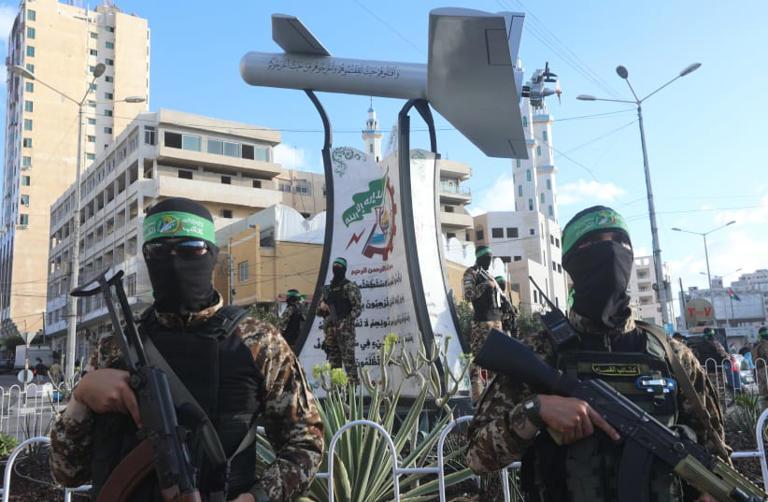
Hamas is preparing long-term insurgency in Gaza
Hamas has been communicating its tactics in Gaza via statements put out in pro-Iranian media for a while now, many by Al-Mayadeen media. They also reflect Hamas’s strategy for Gaza’s future.
For example, Hamas frequently references how it works with other terror groups in Gaza to target IDF forces in various areas of Gaza; one of the attacks’ main focus is Israeli troops in the Netzarim corridor, which increasingly indicates that Hamas is preparing for a long-term insurgency.
The shift in tactics represents the way that Hamas is adapting to the long war. Israel has hinted that the fighting could go on for many months; Hamas knows this, as it has been fighting Israel for decades, often changing its tactics. Hamas seeks to learn from Israel’s actions, and its announcements reflect this learning curve.
While Israeli officials referred to Hamas “battalions” in the early months of the war, Hamas now primarily focuses on small unit attacks. There were 24 Hamas battalions in Gaza in October.
Over time, Israeli officials assessed that the IDF dismantled 12 in northern Gaza and eventually defeated up to 19. This may include up to 14,000 terrorists killed in Gaza. In addition, Hamas suffered numerous casualties, possibly 10,000 wounded, which would seem to indicate it has only a few thousand fighters left. However, it is recruiting.
Another point to note is that estimates of the number of “terrorists” killed do not differentiate between Hamas and other groups, such as Palestinian Islamic Jihad.
Hamas does not release details on men who are killed
Hamas does not release details on the number of its men killed, nor has it stated how many men it has. What it does state is where it is carrying out attacks. It claimed that on Tuesday and Wednesday, it targeted IDF vehicles in Jabalya and the Netzarim corridor. The fact that Hamas and pro-Iran media have adopted the term “Netzarim” shows how keenly they are watching the IDF’s moves.
Al-Mayadeen reported that on the “235th day” of the war, since the “al-Aqsa flood” of October 7, Hamas continued to “engage” Israeli forces through “ambushes.” The report says that “in this context, Hamas’s military wing announced the bombing of the occupation forces stationed in the vicinity of the Rabaa al-Adawiya neighborhood, south of Rafah, with short-range ‘107’ missiles.” This would refer to 107 mm. rockets, a common type of rocket used by pro-Iranian groups in the region. Hamas also claimed it targeted an IDF tank in the Al-Alami area of Jabalya, using an “Al-Yasin 105” munition.
In other places, Hamas said it used “Rajum” missiles and mortars to target Israeli forces. It has focused on fighting in Rafah even as Israeli forces advance. Hamas claimed it detonated an explosive in a house in the Al-Shawout camp area of Rafah. Reports in Israeli media said on Wednesday said the IDF may now control up to 75% of the Philadelphi Corridor.
Al-Mayadeen added that PIJ carried out attacks in Jabalya using mortars, via its military wing, the Al-Quds Brigades. The report claimed the group used 60 mm. mortars, targeting an area near the Salah al-Din gate in Rafah. “It published video clips of its bombing of a position of occupation soldiers in the vicinity of the Turkish Friendship Hospital,” the report said.
Other terrorist groups in Gaza, such as the Al-Qassam Mujahideen brigades, the Al-Aqsa Martyrs Brigades, and the Omar Al-Qasim forces, carried out attacks as well. The National Resistance Brigades, also known as the Martyr Omar Al-Qasim Forces, are “the military wing of the Democratic Front for the Liberation of Palestine.” These groups claimed they carried out attacks in Jabalya and the Netzarim corridor as well as targeting Zikim.
These reports reveal how Hamas and the other groups are settling in for a long-term insurgency, husbanding their resources and using only a few munitions a day in their attacks. Though it is not clear to what extent they coordinate, it is clear that they concentrate on several fronts: Rafah, Jabalya, and Netzarim. This type of fighting reveals that the focus on Hamas “battalions” is likely no longer relevant.
Because Hamas has gone to ground and melted away into urban areas, deploying small teams of terrorists – just a few in any one place – illustrates that the battalion structure has largely shifted to a much smaller type of unit. In places like Jabalya, where Hamas battalions once boasted 1,000 fighters, their numbers have significantly decreased, yet they continue to receive support from other groups.
Source » msn





